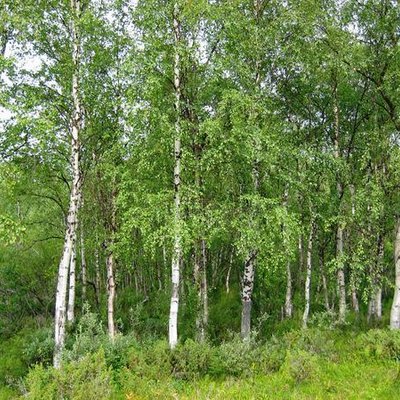Silver Birch Tree Facts
The Silver birch, the national tree of Finland, is a species of birch tree native to northern Asia, Europe and Siberia. The Silver birch has the scientific name Betula pendula and is a close relative of another European birch called the downy birch.
Growth
A Silver birch can grow to be as tall as 80 feet. It experiences rapid growth during the first 20 years and matures by the time it is 40 years old.
Bark
The Silver birch garners its name from the fact that as it matures the bark turns a silvery gray. Young trees have almost pinkish bark. By the time the tree is old, its bark has darkened considerably and taken on a rough and fissured appearance.
- The Silver birch, the national tree of Finland, is a species of birch tree native to northern Asia, Europe and Siberia.
- The Silver birch garners its name from the fact that as it matures the bark turns a silvery gray.
Leaves
The leaves of the Silver birch are diamond-shaped, and they have toothed edges. They grow on thin stems that cause them to flutter in even a very light breeze.
Time Frame
Silver birch flowers appear in April and May before developing into fruit by late June. The fruit ripens in September and goes to seed while the leaves fall off after turning yellow, typically in November.
Uses
When treated, Silver birch wood makes good fence posts. Its twigs were often a component in kitchen whisks and brooms. In spring, some people tap the tree and use its sap as an ingredient in a dry wine.
- The leaves of the Silver birch are diamond-shaped, and they have toothed edges.
- In spring, some people tap the tree and use its sap as an ingredient in a dry wine.
River Birch Tree Facts
The river birch tree often is used for landscaping due to its graceful drooping limbs and attractive color. Hardy in United States Department of Agriculture zones 4 to 9, river birch is the most widely distributed and adapted birch tree in the states. Without pruning, it grows with several trunks. River birch grows under full sun to full shade in highly acidic to slightly alkaline loam, clay or sand. Its leaves turn bright yellow in autumn; in the winter, its showy silver trunk adds beauty to the landscape. River birch also is valuable as a source of erosion control and is used to reclaim areas with high soil acid caused by mining. Ruby-throated hummingbirds drink its sap.
- The river birch tree often is used for landscaping due to its graceful drooping limbs and attractive color.
References
Writer Bio
John Lindell has written articles for "The Greyhound Review" and various other online publications. A Connecticut native, his work specializes in sports, fishing and nature. Lindell worked in greyhound racing for 25 years.



